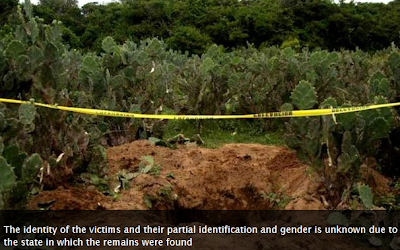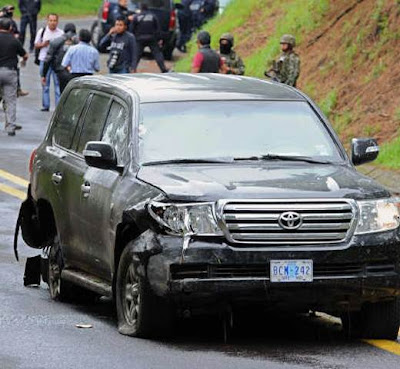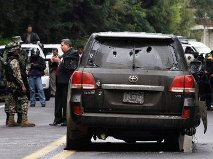Chivis Martinez Borderland Beat
"Assuming that a similar rate of murder continues through the remaining months of this year, the homicide toll at the end of Calderón's presidency will add up to 110,061 victims” ..Molly Molloy
For a shorter version of my "Killing of Innocents" article follow the hyperlink to the one published in Insight Crime
UPDATE 8.29.12
In todays sinembargo there is an post about this subject
Here is an extraction:
"Assuming that a similar rate of murder continues through the remaining months of this year, the homicide toll at the end of Calderón's presidency will add up to 110,061 victims” ..Molly Molloy
Molly Molloy has written an analysis of the narco death toll in Mexico. The above quote is what she states with respect to the total in Calderon’s presidency.
I admire and respect Molloy, however I think her totals are a bit conservative.
My estimation is double Molloys number at 200 thousand+
My estimation is double Molloys number at 200 thousand+
Below is an explanation on how I arrive at that number.
In her post she states that only four Mexican states do not report homicides. I read a report 2 years ago that stated Tamaulipas had no agency tracking narco related deaths. Further, there previously was a non-profit tracking the murders, however, they had disappeared from working in the state. Therefore I am suspicious of the newly found Tamps counts. Two years ago there were 7 states that lacked any official count, and now magically counts have appeared for four.
In a move that is an amazingly blatant misrepresentation of numbers and woefully disrespectful towards victims, The NHRC, (it is directed by a PAN Representative), recognizes only 111 deaths of civilians in 2010 and 43 in 2011. Perhaps the government perceives that citizens can erase from their memory such atrocities as the 2010 San Fernando Ranch Massacre in Tamps of 72 Central American migrants, or the 2011Boca Del Rio Veracruz mass killing of 35, subsequently deemed as having no connection to organized crime. This according to its own PGR agency.
This year the PGR at their National Conference estimated that at least 25k bodies were in clandestine fosas (graves) between the years of 2006-2011. This is the same government that stated there were 111 deaths of civilians in 2010. The truth of the matter is, as stunning as 25k may seem to the majority of people, in truth even 25k is in all probability doesn't come close.
 |
| A portion of the slaughter in Veracruz killing of 35 |
In "hot" states such as Durango, Zacatecas, Coahuila and Chihuahua, in the vast mountains and the massive barren terrain there must be a higher number of dead buried in undiscovered graves. The aforementioned Mexican states are not only violent but Coahuila and Durango has been without any “official” death counts during the drugwar. It would be safe to assume that in the hills and land of the four states highlighted in this paragraph, there are at least 6K per year, which brings one to the government figure of 25k. 25 thousand bodies in undiscovered graves in four states alone.
To grasp the magnitude in which the graves add to the homicide tally, one year later and near the abandoned ranch where the slaughter of the 72 occurred, clandestine graves were discovered containing hundreds of bodies in a small geographical area. During the exhumation of the Tamps graves, in Durango City, another discovery of graves were found in various places of the city, the number of bodies found in Durango surpassed the number of those discovered in Tamps.
In looking at the geographical whole of Mexico, in two cities, relatively speaking, in two small pockets of land hundreds of "missing" victims, some missing for years, were in reality murdered, not "missing".
"Missing" Economic Migrants
Anyone viewing the photos of the San Fernando (Tamaulipas) ranch in the aftermath of the slaughter of 72 Central Americans migrants, will never forget the gruesome, shocking horror captured on film.
In the aftermath of the San Fernando slaughter, there were two survivors. The plight of one survivor was highly publicized around the globe. Credit his escape with the world knowing of what happened to 72 economic migrants in August 2010. There is no doubt those bodies would have been buried in clandestine graves. Had there been no survivors, and the executed buried perhaps the fate of the migrants would have been forever unknown and 72 dead people would have been listed as “missing”
The“missing” must be factored into any reliable narco death tally. “Missing” economic migrants are known to be the prey of cartels, in particular the Zetas. From Chiapas to Tamps, they are kidnapped, extorted, raped, forced into working in the sex trade, criminal activities, and are killed. Then there are those that vanish, vanished to the tune of 50k in 6 years. At some point they must be declared dead and placed in the drugwar dead column.
Contributing incalculable factors:
The number of omissions or misreported homicides is unknown; however it is known that cities and states that deaths will intentionally misidentify deaths as natural “accidental” or even “suicide”. Then there is the counting in of itself. I frustratingly refer to this as “Messican” math. 3 agencies are at the same crime scene and one will report 8 bodies, another 5, and yet another 12.
States lacking "official" must be taken into account. 4-7 states are without official counts. Hot spots such as Coahuila, Durango and Tamps.
Molloy mentions the many articles from respected sources that are now beating the drum of the hidden figures. One recent article being from Reforma, an extraction below:
“La falta de investigacion de los homicidios por parte de autoridades estatales y federales, la ausencia de coordinacion para determinar cuales estan vinculados al crimen organizado y cuales no, ademas de una metodologia endeble, son factores que impiden conocer la cifra real de ejecutados, opinan especialistas en seguridad publica. “
Add the 50K for "missing migrants", 25K for undiscovered fosas, and a very conservative number for 6 years of 6k total in the 4 states with no counts, one can see how a number of 200K can be reached, quickly and conservatively without consideration of other factors.
Molloy mentions the many articles from respected sources that are now beating the drum of the hidden figures. One recent article being from Reforma, an extraction below:
“La falta de investigacion de los homicidios por parte de autoridades estatales y federales, la ausencia de coordinacion para determinar cuales estan vinculados al crimen organizado y cuales no, ademas de una metodologia endeble, son factores que impiden conocer la cifra real de ejecutados, opinan especialistas en seguridad publica. “
"The lack of investigation of homicides on the part of federal and state authorities, the absence of coordination to determine which are linked to organized crime and which not, and weak methodology, are factors that impede knowing the real figure of executed, reports security specialists." Reforma
Building on Molloy's "count" of 101KAdd the 50K for "missing migrants", 25K for undiscovered fosas, and a very conservative number for 6 years of 6k total in the 4 states with no counts, one can see how a number of 200K can be reached, quickly and conservatively without consideration of other factors.
Below is the analysis from Molly Molloy of the narco death toll in Mexico. Her calculation totals 101,203 murders during Calderon's term. She also hits on the issue of the number of innocents. In a recent report of hers she stated:
“Mexican government along with some media outlets state that 90 percent of those killed in the violence involved in the drug trade, Molloy argues that out of the 10,800-plus victims killed in the border city of Ciudad Juárez since 2007 the vast majority of them had no involvement in the cartels. With a population of only 1.2 million residents, Ciudad Juárez accounts for 10 percent of all of Mexico's murder victims since 2007.”
We may never know the official tallies, as the Mexican Government ceased publishing their official counts.
We may never know the official tallies, as the Mexican Government ceased publishing their official counts.
The Following is Molloy's post:
This article by Luz del Carmen Sosa appeared yesterday in EL DIARIO…I have not found a link to the original yet, but this one from puronarco.comseems to be complete. There is also a translation from Borderland Beat. If anyone has the full original version of the article from El Diario, please post or send me the link.
Highlights: government data from the Public Ministries of 28 states on homicides (specifically homicidios dolosos or intentional homicides) were provided through the Mexican transparency law (similar to the US Freedom of Information Act). The data reveal that from Dec 1 2006 when Calderon took office up through December 2011, there have been at least 83,541 homicides. The four states that DID NOT report homicides are: Coahuila, Durango, Morelos and Tlaxcala. I know from following media reports and in looking at the previous releases from different government agencies that Coahuila and Durango have been very violent during the years of Calderon’s administration. Some of the most violent mass killings have been reported from the Lagunera area that includes parts of both Coahuila and Durango state. The investigation is continuing with the effort to obtain data from these states as well. The officials are legally obligated to provide the information.
At least 8.4 percent of the victims nationally are women, though state authorities cannot determine the sex of 184 of the bodies counted. Most of the homicide victims are between the ages of 21 and 30.
The states with the most homicides are Chihuahua (16,592) and Estado de México (8,602). Though not in the article, it should be noted that the Estado de Mexico (essentially includes all the population in the central area around the capital city minus the population of the Distrito Federal) and it is the largest in population of all the states of Mexico with more than 15 million inhabitants. Chihuahua with twice as many homicide homicide victims has a population of 3.4 million
The article reports 1,304 of the 16,592 homicide victims in Chihuahua state were women–the highest number of “feminicidios” in the country. This statement is relatively meaningless in terms of the statistics because Chihuahua also had by far the highest number of homicides overall. The percentage of female victims in Chihuahua is actually about 7.8 percent, slightly lower than the overall percentage of female victims in all of the states reporting (8.4 percent). So in relation to the TOTAL victims, there were relatively fewer female homicide victims in the state of Chihuahua compared to those in the other states. In other words, yes, there are more murders of women in Chihuahua than in any other state. But that is because there are so many more murders total in Chihuahua… And, the percentage of female victims is actually slightly LOWER than in other states.
The article does not give the exact figure reported for Ciudad Juarez, but says that the city had the highest number of homicides in the state, followed by the capital, Chihuahua City. The border city of Juarez had nearly 11,000 murders from Dec 2006 through December 2011 and accounted for 13.4 percent of all the murders in Mexico.
In terms of the quality of the data, the article indicates serious omissions. Chiapas (for example) reported only 77 murders in the time period (dec 2006-dec 2011) but the official reporting for the public ministry there says:
“From 2006-2009 no record was found of any homicidios dolosos.” Chiapas appears only to have started counting in 2010.
Extrapolating from these data provided by the public ministries of the 28 states reporting, we have a base number of 83,541 homicides from Dec 2006-Dec 2011, we can use the number reported nationally by the Sistema Nacional de Seguridad Publica (SNSP) of 8,622 homicides between January-May 2012.
That is an average of 1,732 homicides per month. [see: Insight Crime for this number from SNSP] … Considering that the murders have been reported to be decreasing slightly in 2012, let’s estimate an average of 1,500 homicides per month for June-November 2012 (Pen~a Nieto will take office Dec 1 2012) for an estimate of 9,000 more homicides for the remainder of Calderon’s term. Added to the 92,203 as of the end of May we get an estimate of 101,203 homicides. Keep in mind that the data obtained through the transparency law and reported in this article does not include ANY numbers from 4 states, including two very violent states: Durango and Coahuila.
Dec 2006-Dec 2011 = 83,541
Jan-May 2012 (SNSP data) = 8,662
TOTAL as of end of May 2012 = 92,203
Estimate June-Nov 2012 = 9,000
Est. TOTAL Calderon’s term = 101,203
For a person who was always bad at math, I am polishing up at least my arithmetic. I have looked at the numbers reported by INEGI for 2005-2010. From those numbers we can at least get 4 years of data quickly for the states that did not report homicide numbers and this gives us another estimate of at least 106,392. Considering the missing data and state entities that seem not to have counted homicides at all for several years, I believe it is very reasonable to estimate that by the end of Calderon’s administration more than 110,000 Mexicans will have been victims of homicide.
The Government has the obligation to provide true figures. Never did. When they tried to count the number of children killed during the war, they then refused to give the number. We knew over the network for the rights of children in Mexico in October of last year that its accounting provided the figure of 1,400 children executed. They are tiny "collateral damage” hidden by the Government under the mat .
Calderón prefers to hide thousands of deaths under the carpet. The US State Department said last March that the figure was 150,000 dead.Calderón prefers to hide thousands of deaths under the carpet. He thinks we will forget.
He is mistaken. Every person, every human being, every woman, every man, every child, every elder, every mother, each parent; grandfather or brother, uncle, nephew, friend, known, neighbor... have full name. And someday them we will have one by one, although we take years, decades.. The Government does not want to talk about another reality: those displaced by the violence. Entire villages have been emptied. .In November of last year we learned that 1 million 600 thousand people left their homes in Chihuahua, Sinaloa, Tamaulipas, Coahuila, Durango, Baja California, new León, Michoacán, Guerrero and Veracruz, according to a study of Fidel Lopez Garcia, academic of the Instituto Jose Maria Luis Mora and consultant to the United Nations for displaced people.



































